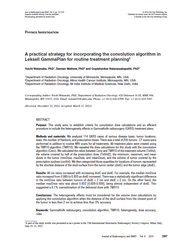- Home
- Journal Contents Downloads
- JRSBRT Downloads
- JRSBRT 8.4, p. 305-312
Product Description
A retrospective study on clinical factors influencing intra-fraction motion using volumetric imaging for spine stereotactic body radiotherapy
Sankar Venkataraman, Michael Abdalmassih, Nikesh Hanumanthappa, Vibhay Pareek, Rashi Kulshrestha, Pascal Lambert, Srinivas Rathod, Jim Butler and Arbind Dubey
Objectives: Stereotactic body radiation therapy (SBRT) for the spine is challenging due to high-dose gradients sparing the cord in the treatment plans. We present our findings of initial setup error and intrafraction motion from Cone-beam computed tomography (CBCT) imaging.
Materials and methods: A total of 47 patients treated with spine SBRT with a total of 154 fractions following a fractionation schedule of 16 Gy in 1, 24 Gy in 2, and 30 Gy in 5 fractions were part of this study. Pre-treatment CBCT was used for localization of the target and couch shifts were applied based on target volume matching to the planning CT image set. Post-treatment CBCT was acquired for all fractions. Intrafraction motion (IFM) was calculated by matching post-treatment CBCT to planning CT for the target volume.
Results: The average Intrafraction motion was 1.6 ± 0.9 mm for the study cohort. The average and standard deviation of intrafraction motion were 0.4 ± 1.1 (AP), 0.3 ± 0.9 (SI) and 0.2 ± 1.2 (RL) respectively. The average Initial setup error tabulated from the offline review showed a mean value of 7.8 ± 5.3 mm. The average and standard deviation of the initial setup error were 2.5 ± 5.5 (AP), 2.4 ± 5.3(SI), and 0.8 ± 4.5(RL) respectively. The correlation of intrafraction motion with body mass index (BMI) and the number of consecutive vertebrae levels did not show any statistical significance, however, there was a significant association with gender as women showed more IFM
Conclusions: Our study on intrafraction motion from CBCT images reinforced the importance of immobilization and imaging for positioning spine SBRT patients.
Advances in knowledge: The need for CBCT and imagining for positional errors is emphasized while treating with SBRT spine and the need for proper immobilization techniques
Keywords: Spine metastases, SBRT, CBCT, intrafraction motion
 Loading... Please wait...
Loading... Please wait...








